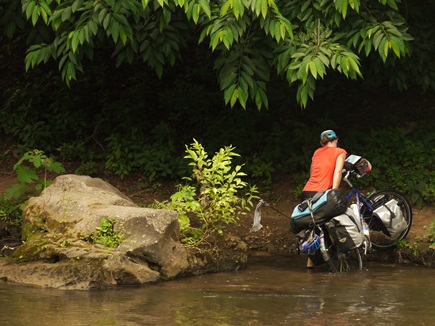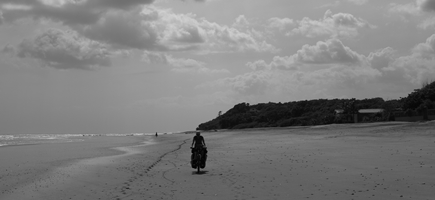Nica beach cruising
July 15th, 2012
Riding the beach was something we’d long wanted to do on this trip – but so far it had never quite worked out.
Having battled the heat, trucks and tedium of the Interamericana for the previous few days on our dash across Honduras, we were keen to find an alternative route down through Nicaragua. And so, after a few days of rest and relaxation in León, Nicaragua’s revolutionary capital, we bid a sad farewell to Nate – who was off to the USA to buy some new tyres visit his girlfriend – and set off for the beach.
Our map showed a network of minor roads which in theory would allow us to keep west and track down the Pacific coast. On paper, it looked perfect – but not for the first time, our map was a triumph of optimism over the reality of Central American backroads. Gradually, the roads became rough tracks, then trails – and then disappeared entirely.
However – as has always been the case when we have given up on the map and relied on locals’ advice from village to village – it made for a memorable few days, and finally delivered our long-awaited fix of beach riding.
James
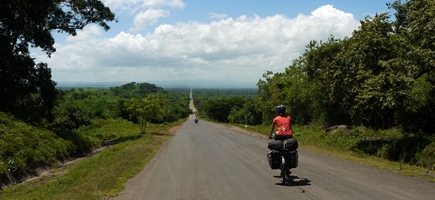
A welcome break from truck dodging – the almost deserted (and very straight) old highway from León to Managua. We followed this as far south as Santa Rita, where we turned off towards the seaside towns of Masachapa and Pochomil and stopped for lunch. We've learned that we always cycle better in the morning, and so the decision to stop to eat has turned into an epic battle of wills, as both of us fight to stave off the pre-lunch wobbles and churn out a few more km.
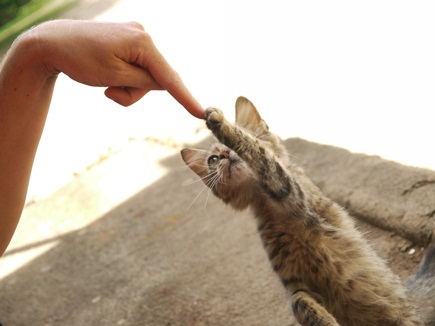
When one of us finally does crack, we fall into a heap at the side of the road – and almost always find a friend hoping for scraps. Needless to say, begging from hungry cyclists is very rarely profitable…
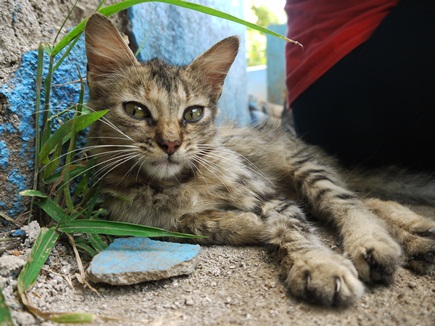
…even when you're this cute. If Bedders had her way, this guy would have been into her handlebar bag in a flash, and coming on a very long holiday.
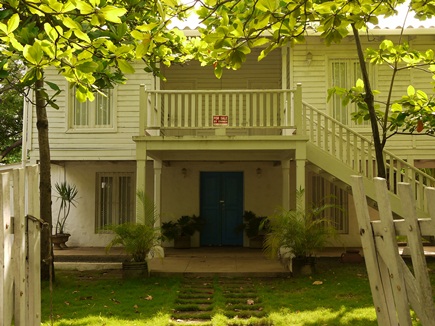
After a night in Masachapa, we headed along the coast to Pochomil. As the closest beaches to Managua, this stretch of coast used to be popular in the past with weekenders from the city, but with the rise of the more fashionable San Juan del Sur in the south it has a faded air. Desperate restaurant owners chased us along the beach for our business, and most of the luxurious beach-front homes like this one seemed to be up for sale.
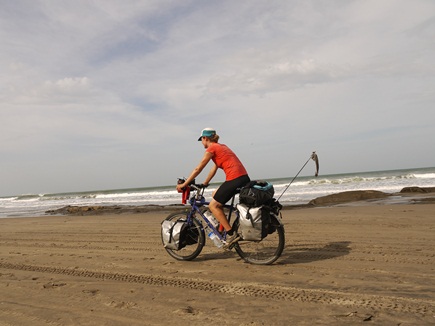
We started to ride the beach from Pochomil towards La Boquita – but were stopped by locals who told us with the tide coming in we would never make it across a deep channel which lay ahead. First lesson of beach riding – it's all about the timing.

Instead we cut inland, where we found a track which snaked its way through enormous sugar cane plantations and tiny coastal villages. Two friendly engineers from the plantation company on motorbikes stopped ahead at each junction to make sure we were headed on the right track.
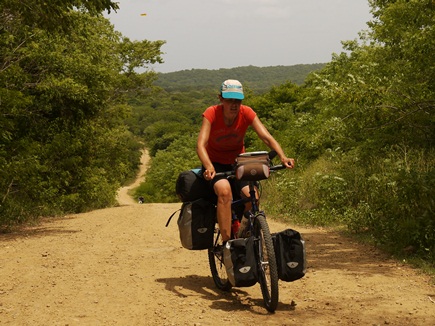
Remember Anneka Rice? Well let me introduce you to her Central America reincarnation: Anneka Rice and Beans. She's been revamped for a new eco-friendly generation, ditching the helicopter for a bike. She eats hills for breakfast…
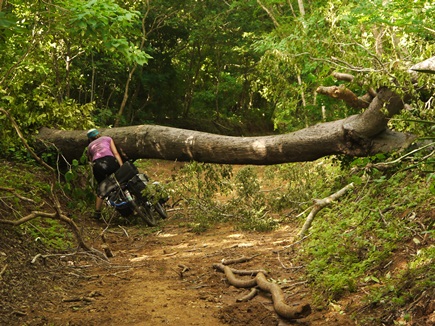
…and limbos trees just for fun. The question is – what happened to the all in one lycra suit? So far, all I've seen have been the shorts…
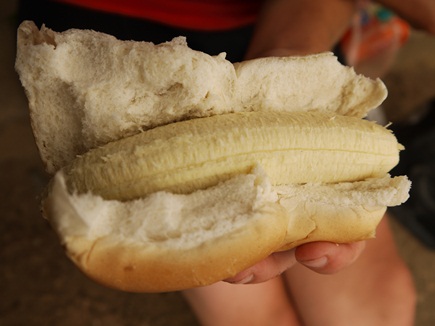
Bananas have taken centre-stage in our Central American diet. They're cheap, filling and – when added to a hot dog roll like this – distinctly gourmet.
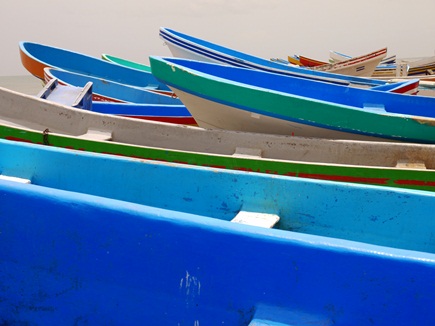
After popping out in La Trinidad, we hit tarmac again for an easy freewheel back down to the coast at Casares, the biggest fishing village along the coast. The boats were already hauled up out of the water for the day, and pigs snuffled amongst them looking for shade and scraps.
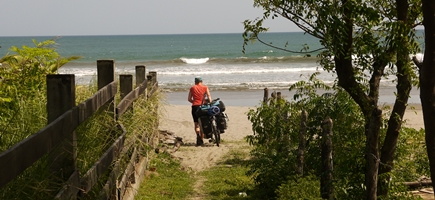
Beyond Huehuete, the “main highway” marked on our map came to an abrupt end – clearly the map makers' optimism exceeded the Nicaraguan government's funds when it came to road improvements. A quick consultation with some locals revealed that the beach was by far the best way to continue our route south – and this time we were in luck.
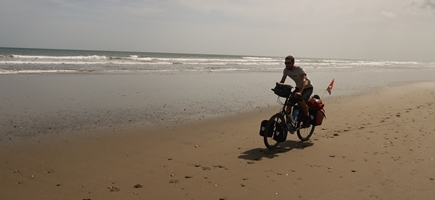
The tide was out, revealing a perfect highway of wet, hard-packed sand and a window of a couple of hours to reach the village of El Astillero 20km south, where we could rejoin the coastal road.
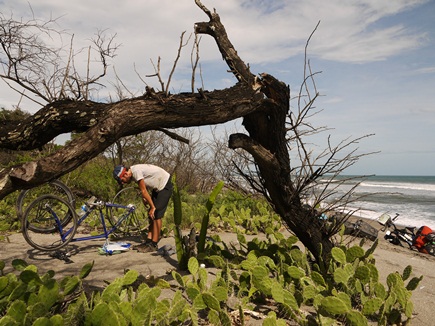
…SNAP! The metallic sound that every cyclist knows and dreads, and Sarah's first broken spoke of the trip. A quick beach repair and we were off again…then HISS! A puncture in the same wheel. Suddenly our window of time was looking very tight, and our water bottles almost empty. We decided to cut our losses for the day and find somewhere to camp.
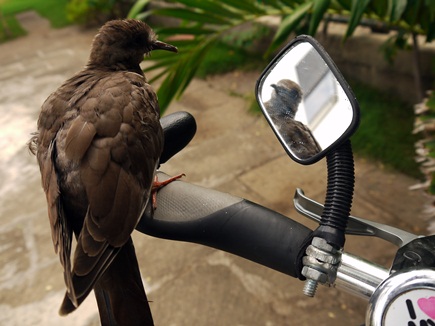
As always, it was a local to the rescue. Ramón was looking after one of the beachfront villas nearby and had watched us struggling with the wheel. He filled our bottles and invited us to camp. A dove provided the evening entertainment, preening itself in Sarah's mirror before attempting a bizarre and suicidal landing in our pan of boiling pasta.
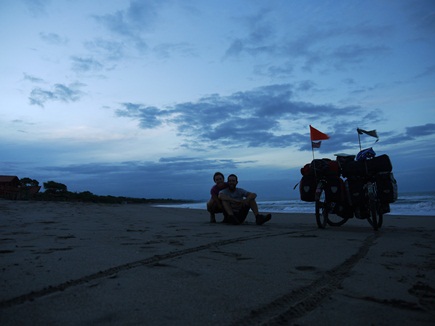
We were up at dawn, having worked out that we should have another window of time to ride the beach to El Astillero while the tide was out.
Some locals had beaten us to it, providing us with a perfect set of tyre tracks to follow. Squadrons of pelicans skimmed the waves just offshore, and hermit crabs scattered in front of us in every direction, racing to tuck themselves away inside their shells.
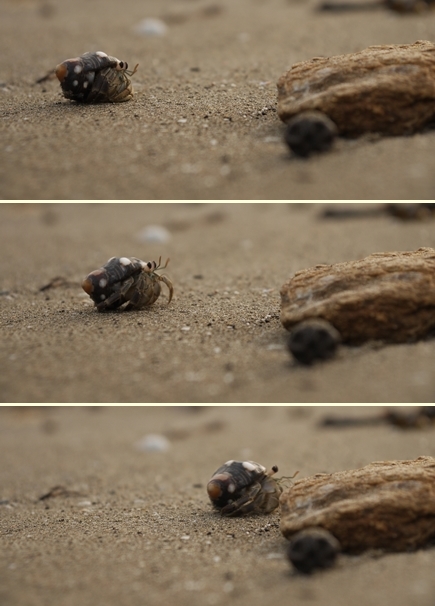
Stop for a minute though and they would nervously emerge: first, the eyes, like miniature periscopes; next a tentative claw; and finally, in a whir of legs, off they would scuttle.
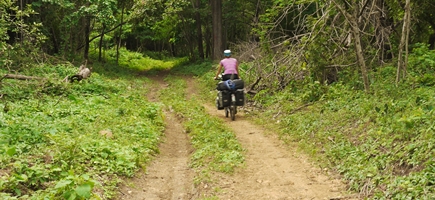
We made good progress for about 10km until just before Veracruz, where the beach once again became steeper and the sand deeper, swallowing our heavy bikes. We were stuck. Luckily some local fisherman were on hand to help us drag our bikes off the beach. They walked us inland and onto a beautiful track that they assured us would lead us south…
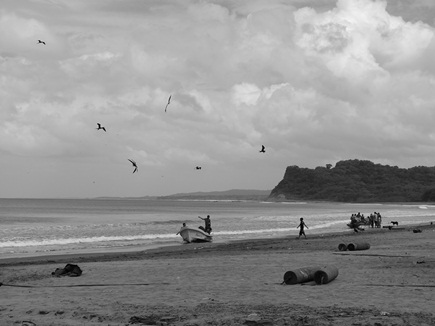
…which it indeed did. And so, 12 hours later than expected, we finally arrived in the fishing village of El Astillero – just as the morning catch was being brought in and sold along the beach.
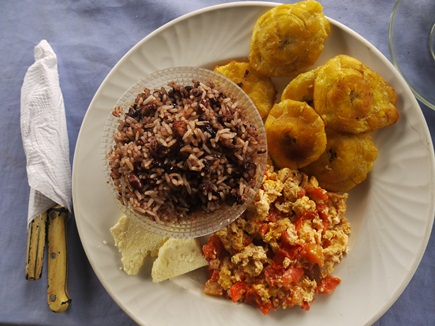
For me, there's only one meal better than breakfast – and that's second breakfast. We celebrated our beach ride with a typical Nica feast: gallo pinto (rice and beans cooked with herbs), tostones (fried plantains), scrambled eggs with tomato and onion and a slice of crumbly, fresh cheese.
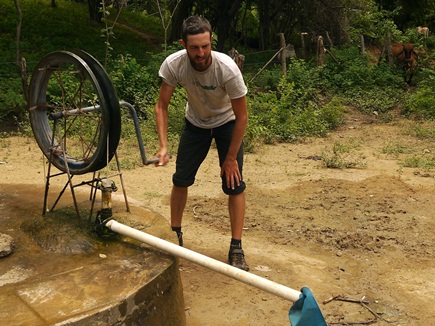
With our beach jaunt over for the time being, we turned inland again and headed across the narrow isthmus towards Lake Nicaragua, where we had planned a few days on Ometepe Island. First we stocked up on water from this ingenious bike wheel well…
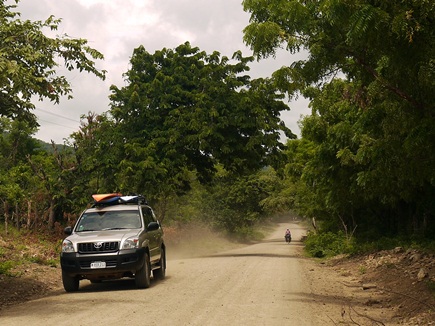
…before heading for Tola across a changing landscape. The roads became wider and faster, surfboards appeared strapped to flash 4x4s, and the signs suddenly all switched into English. We were clearly back in gringo holiday home territory.
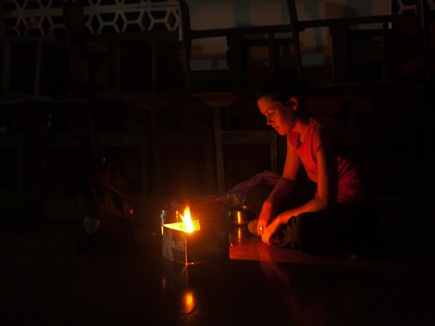
After a drowning in a mid-afternoon thunderstorm, we arrived in Rivas tired and soggy. Feeling cheap, we thought we'd try our luck at the local bomberos (fire station) – who sure enough were happy to let us fire up the stove and crash on their floor…
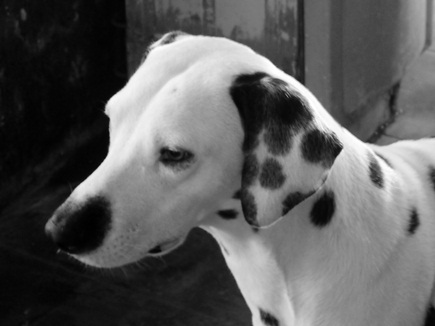
…all under the watchful eye of their dalmatian, Capitán. But we were more fascinated by a particularly memorable fireman, who our friend Andy had encountered and photographed when he stayed here a few weeks before. We wondered if we were in for a repeat performance, and sure enough…
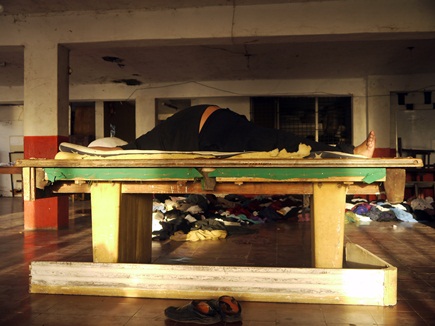
…here he is. Possibly the fattest fireman you'll ever see, snoring away peacefully on the pool table. It was all very Nicaraguan really – a flat green plain punctuated by a perfect volcanic cone. Apparently (and I'm not sure how this was physically possible), he actually shared the pool table with another guy when Andy was there – maybe since then they've had a falling out over one of them stealing the covers…
Isla de Ometepe
July 16th, 2012
It’s taken me a few years to admit it but I will finally state that boats and I just don’t agree. Being of a weak-stomached constitution, I get seasick at the slightest swell and usually feel a desperate urge to jump off and swim for the horizon. That all bodes well for the forthcoming FIVE day sailing trip between Panama and Columbia then…hmmm, let’s see how that pans out.
Nevertheless, I love islands and the boat journey that stood between me and Ometepe, nauseating as it was, didn’t put me off the tranquil wonders of this beautiful island on Lake Nicaragua. Perfect for cycling, being only 31km long and at its maximum only 10km wide, we were tempted by its two majestic volcanoes, and the prospect of some lakeside riding.
Sarah
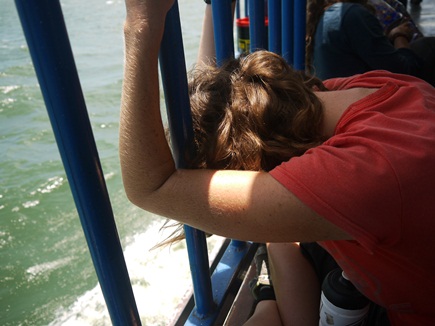
Hanging on for dear life, closing my eyes and thinking of England: all ineffective ways to ignore seasickness.
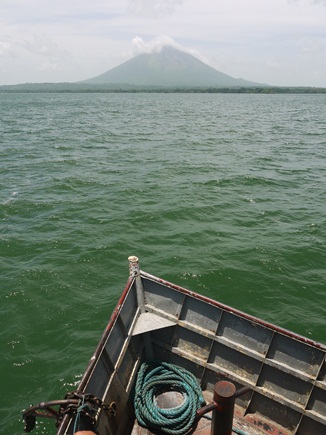
An hour later and the first of the island's two volcanoes came into view and I knew we were in for some picturesque riding.
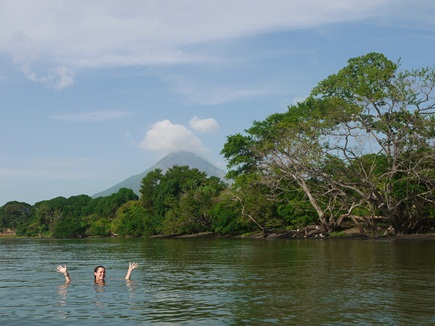
Shortly after arriving on the island, the seasickness having abated a little, we dipped into the lake and had the cool calm waters pretty much to ourselves.

Over the last year, we've got used to people stopping in their tracks to stare at us and the bikes as we trundle past – perhaps it's the lycra shorts – and these kids on the island were no different, seemingly oblivious to the beautiful backdrop, they stood open mouthed as we passed them by.
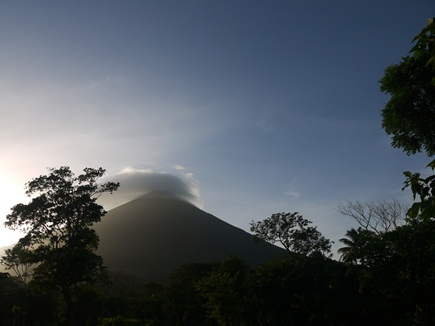
The sun starts to go down behind the bigger of the two volcanoes, Concepción, as we ride to our first destination. On the way we see howler monkeys, herons, hundreds of butterflies and hoardes of lush vegetation with stunning tropical flowers sprouting out of soil made fertile from volcanic ash. Apparently, Concepción is considered the “finest volcano cone” in Central America…high praise indeed.
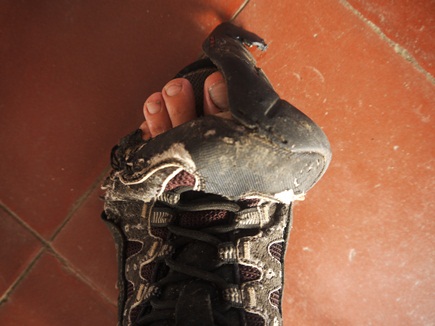
We might be in a Central American paradise, cycling past stunning natural wonders but the practicalities of the trip still have to be attended to. James' shoes suffer the consequences of too much Alaskan rain, a year of riding in all conditions and then the final nail in coffin was the hike up another volcano, Santiaguito in Guatemala, in May. With a new pair on order for collection in Panama City, these will have to make do until then, so out comes the duct tape…

Day two on the island saw us take a southern loop around the second, smaller volcano, Maderas. The road was dirt and pretty rocky at times through tiny villages and right along the lake.

Aside from James taking a dramatic head-first tumble into a rocky ditch like this one, it was the perfect Sunday afternoon ride.

We camped at Finca Magdalena, an organic coffee farm, and finished the day with hot strong Nicaraguan coffee and fried plantains with fresh mild cheese.
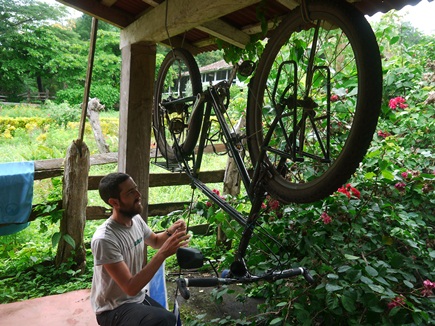
A relaxing third day was marred slightly when it began with a frustrating and sweaty hour tring to retrieve a pack of spare spokes that had been stored in James' seat post. With limited places to put things, we smugly thought that storing them here would be smart, until we realised that they'd slipped down further than we could reach and the only way to get them out was a “chopsticks” manoeuvre whilst the bike was hung upside down. And yes, we did receive some very curious looks from the staff and other guests at the finca.
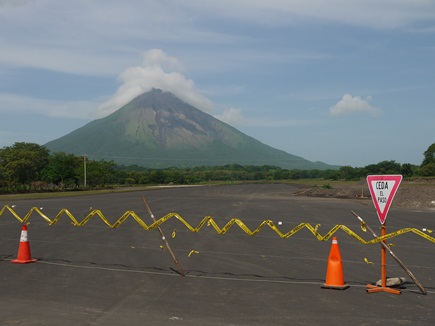
It's not the volcano cordoned off here – although Concepción is remarkably active, the last eruption being in 2010 – the taped area is the building site for an airstrip. If/when this becomes a reality, an influx of tourists by air looks likely to change the laid back unspoilt feel of the island.
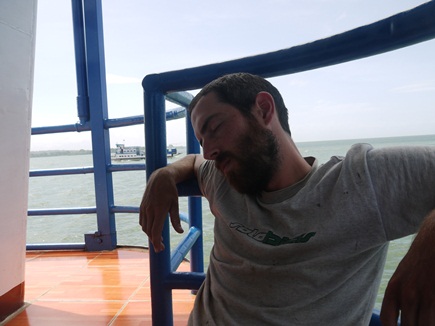
A rain shower and a night's camping at Charco Verde rounded off the trip and we headed for an early morning ferry to continue our route south through Nicaragua, hoping that we might catch up with some nesting turtles on the Pacific coast. It was a smoother journey back to the mainland but still, James copes with ferry crossings far more calmly than I do…maybe I'll try his snoozing technique next time we have to get on a boat.
Magical turtles
July 20th, 2012

One of only seven beaches where mass arrivals of nesting turtles occur, Reserva la Flor is a beautiful spot. As the sun goes down, we prepare to walk the beach and scan for turtles arriving to lay their eggs – over 100,000 of them use this beach to nest every year.
In the wrong place at the wrong time to see the migrating whales in Baja California back in November, we were determined not to miss a chance to see nesting turtles in Central America. So after Ometepe, we crossed back over to the Pacific coast of Nicaragua to visit Reserva La Flor. Olive Ridley turtles begin “arribadas”, mass arrivals, here in vast numbers in July so we were hoping to get lucky and see some ladies land on the beach to lay their eggs. A lovely dirt road ride took us from San Juan del Sur to Reserva la Flor, where a real treat lay in store for us.
The warden of the reserve waived our camping fee and only charged us half price to enter the reseve – he seemed shocked and amused when we showed up on bikes. We didn’t ask for any favours but it’s always so nice when someone warms to us simply because of the way we’re travelling. We spent the night camped outside the military dorms; they have a 24 hour military armed guard here to protect the turtles’ eggs from poachers.
Under a beautiful sky packed with stars, we are lucky to see an Olive Ridley turtle make her way back to the ocean having laid her eggs and another enormous Green Turtle, who also use the beach, in the process of nesting as we and other visitors look on. No flash photography is allowed as it disturbs the mothers so without the camera, we watch breathlessly as these amazing creatures follow their nesting patterns which haven’t changed for thousands of years.
There is no mass arrival on the night that we’re there but we feel privileged to have seen these two turtles at all. Little are we to know that the next morning, we’re in for another exceptional treat – this time with the beach to ourselves…
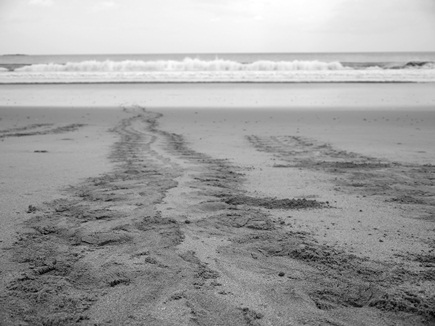
We wake at 6am to be told that during the night over 200 turtles came to lay eggs on the beach. We're in luck as the warden tells us to head straight to the beach where an Olive Ridley is making her nest in the daylight. Tell-tale tracks lead us to where the turtles have exited and returned to the ocean…

…and to the Olive Ridley who has begun digging her nest, under the watchful eye of one of the soldiers. These turtles take less than an hour to lay about 100 eggs and might come back a number of times during one season.

It's tiring work as the turtle has to dig out a hole in the sand deep enough to hold her eggs with just her flippers. She stops every few moments to take a deep breath and lets out a weary sigh before carrying on. She looks for all the world like she'd really rather be doing something else.
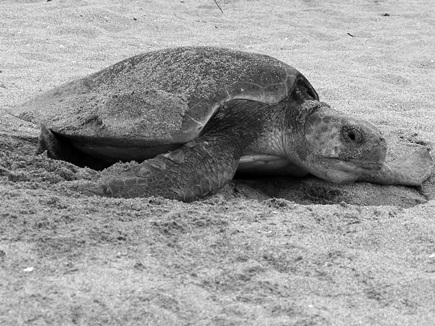
Now she has laid the eggs, it is time to cover them over and pack them down to give them the best chance. The turtle launches herself up and down onto the sand to pack it down making an odd thumping sound and looking most ungainly. These creatures are so much more graceful once in the water.

And the result of her labour of love: a nest of disturbed sand. It will be 50-60 days before the eggs are ready and then the babies will hatch all at once to ensure a greater chance of survival. If they survive the dash into the ocean (and are not defeated by sun, predators, poachers or dehydration first) they will travel as far as Alaska and Chile before the females return here to nest as their mothers have done.
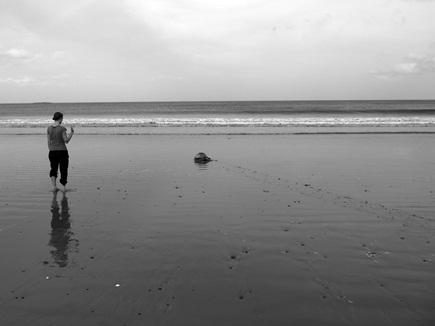
… while I follow behind to wave her off, pinching myself at how lucky we were to have witnessed this fascinating and humbling ritual.
Sarah
